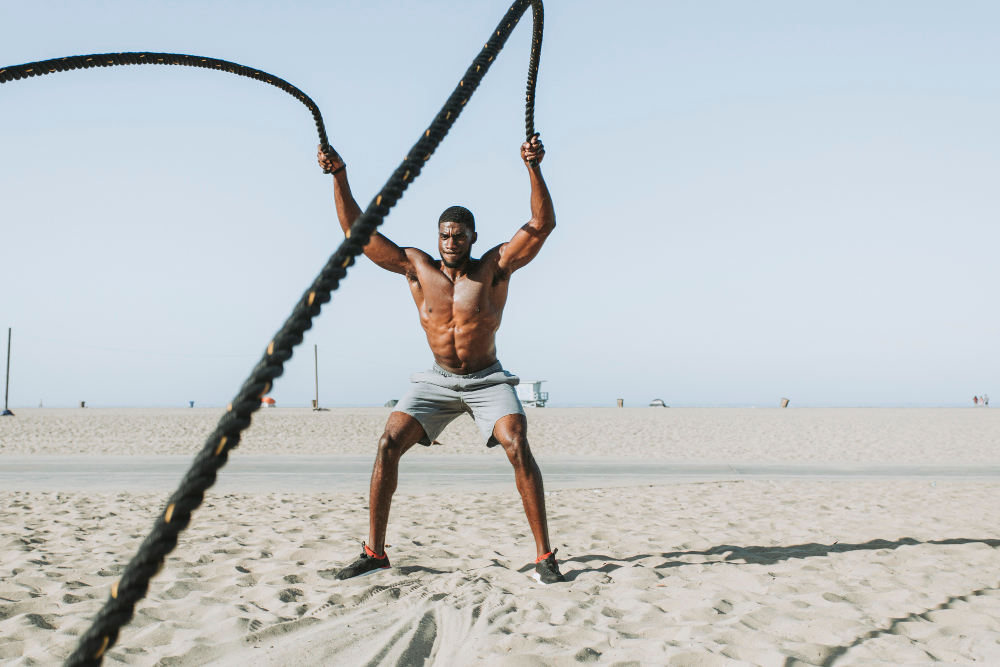So you want to do a battle rope workout at home, you’ve got the ropes, and you have an exercise plan in mind. All that’s left to do is set it up. Luckily, we’ll cover many options on how to do it. No matter if you have a home gym or just a few tools. Let’s see how to set up battle ropes.
8 Ways to Set Up Battle Ropes
When it comes to a DIY battle rope anchor, you’ve got plenty of options. Some are more “official,” while others are just smart hacks that get the job done. Here are some of the most effective ways:
Battle Rope Anchor Kit
The simplest and cleanest method. These kits are cheap, easy to install, and keep your ropes from sliding all over the place. If you have a place where you can set it up, then it’s definitely worth getting one.
Barbell with Heavy Plates
Load up a barbell with big plates, lay it on the floor, and thread the rope through the middle. Just make sure the plates are heavy enough to stay put.
Kettlebell
A heavy kettlebell works perfectly. Go heavier than you think, because a battle rope workout can drag a lighter bell across the floor.
Sandbag
If you’ve got a solid sandbag, you can use it as your anchor. It’s functional and portable. So one time you can do a battle rope workout in your home gym, and the other time outside.
Weighted Sled
Perfect if you already own one. The sled keeps your ropes grounded. Just make sure you add enough weight if the structure itself doesn’t hold everything without moving.
Fixed Gym Structures
Elements like squat racks, pull-up rigs, or anything bolted to the floor. Just loop your ropes around and you’re good to go.
Tree Trunk
If you’re outdoors, a sturdy tree trunk is as reliable as it gets. Wrap it around the tree and start your workout.
Fence Post
As long as it’s strong and stable, a fence post does the job. Test it first. You don’t want your fence leaning after a workout.
Best Places to Set Up Battle Ropes
Battle ropes need room to breathe. Trying to squeeze a workout into your living room, surrounded by couches and coffee tables, is a recipe for scratched floors or banged-up furniture.
A better option? Go where you have space and durability on your side. The garage is a classic pick. It’s open, sturdy, and usually has a concrete floor that can take the punishment. A backyard works great too, especially if you anchor the ropes to a tree or fence post. And if you’ve got a home gym with mats, that’s even better.
No matter where you set up, the key is space. You’ll want enough room not just for the ropes themselves but also for lunges, jumps, and whatever movements you throw into the workout.
What Kind of Battle Ropes Should You Get?
If you don’t have a battle rope yet, pay attention to two main things: length and thickness. The most popular options are 30 ft and 40 ft in length, and 1.5 or 2 inches in thickness. Let’s break down the differences.
30 ft vs 40 ft Battle Ropes
When choosing between 30 and 40 ft, think about two key factors: the space you have and your fitness level.
Remember, the length of the rope is cut in half once it’s anchored. A 30 ft rope gives you about 15 ft per side, while a 40 ft rope gives you 20 ft per side. Longer ropes move more smoothly and are easier to control, while shorter ropes can feel a little choppy or awkward. If you’ve only got room for 30 ft, that’s totally fine, just know it may feel different.
For beginners, shorter ropes are often the better option. They’re easier to handle and make it simpler to keep good form, especially if you’re using them for cardio conditioning. If your main goal is strength training, you might be able to handle a longer rope, but don’t sacrifice technique just to go bigger. Start with the easier option, then upgrade as you get stronger and more comfortable.
1.5 vs 2 Inch Battle Rope
The thickness of the rope depends on your fitness level. The thicker the rope, the harder it is to use.
Use the same logic as you would for rope length. If you’re brand new to exercise, not just to battle ropes, stick with a 1.5-inch rope. It’s easier to grip, easier to move, and will help you learn proper form.
If you’ve been training for a while and already have a solid fitness base, you can probably handle a 2-inch rope. It’s heavier, tougher to grip, and delivers more of a strength-focused workout.
Pro Tips
Once you have your battle ropes set up, here are two tips you should keep in mind:
Take care of your battle ropes
If you want your ropes to last, treat them right.
- Avoid dragging them across rough concrete since that’s the fastest way to make them fray.
- Use mats or rubber flooring whenever possible, or at least place something under the anchor point to reduce wear.
- Store them indoors when not in use, especially if they’re made of poly or natural fiber since sun and moisture will break them down over time.
- Coil them neatly instead of tossing them in a corner.
Watch out for blisters
Your hands will take a beating if you use battle ropes often.
- To prevent blisters and fatigue, wear workout gloves. Look for ones with good wrist support and breathable material so your hands don’t overheat.
- If you prefer training barehanded, chalk is a solid option for a better grip.
FAQ
Do I need special flooring for battle ropes?
Not really. Concrete, mats, or rubber flooring work best since they protect both your ropes and the floor. Avoid hardwood or tile because ropes can leave marks.
Can I use battle ropes indoors?
Yes, but it works best in a garage, basement, or home gym. Living rooms are not ideal because of the furniture and flooring.
How long do battle ropes last?
A good rope can last for years if you use it on the right surface and store it indoors.
Can I get a full workout with just battle ropes?
Definitely. They build cardio, strength, and endurance. If max strength is your main goal, mix them with weight training.
Key Takeaways
Setting up battle ropes at home doesn’t have to be complicated.
- You can anchor battle ropes in many ways, such as with a barbell, kettlebell, sandbag, or even a tree.
- The best places to set up are areas with space and durable flooring, like a garage, backyard, or home gym.
- Rope size matters. Beginners should start with a 30 ft, 1.5 inch rope, while more advanced athletes can handle longer or thicker options.
- Focus on proper form first. Choose the rope length and thickness that match your fitness level and available space.





